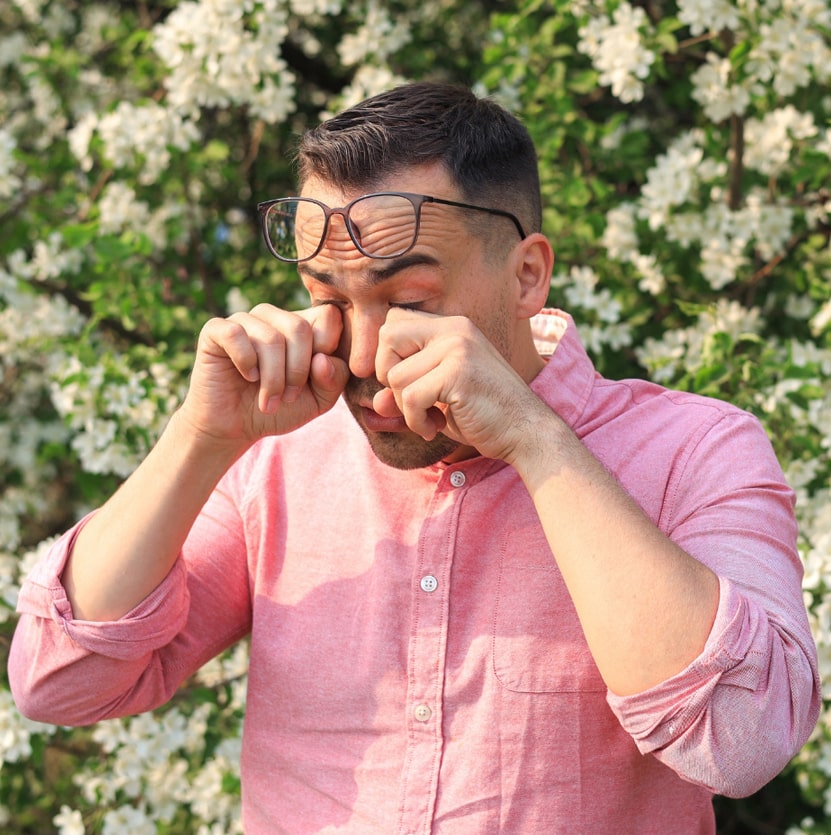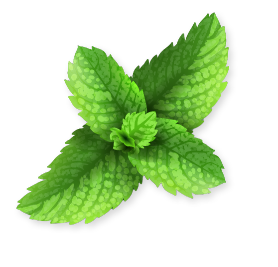Ayurvedic Treatment for Allergic Conjunctivitis in Kerala
What is Allergic Conjunctivitis?
Allergic conjunctivitis is an inflammation of the conjunctiva, the clear tissue covering the white part of the eye and the inside of the eyelids, caused by an allergic reaction to substances like pollen, dust, or pet dander. This condition leads to red, itchy, and watery eyes and is often associated with other allergic symptoms such as sneezing and nasal congestion. It can be seasonal, occurring during pollen-heavy times of the year, or perennial, affecting individuals year-round due to constant exposure to allergens.

Symptoms
1. Redness in the Eyes: Inflammation causes the eyes to appear red or bloodshot.
2. Itching: Persistent itching of the eyes is a hallmark of allergic conjunctivitis.
3. Watery Eyes: Excessive tearing or watering of the eyes due to irritation.
4. Swollen Eyelids: Puffiness or swelling of the eyelids, particularly in the morning.
5. Burning Sensation: A feeling of burning or discomfort in the eyes.
6. Sensitivity to Light: Photophobia or increased sensitivity to light.
7. Gritty Feeling: A sensation of having something in the eye, despite no foreign object being present.
8. Discharge: A stringy, mucus-like discharge, especially upon waking.

Causes
Allergic conjunctivitis is triggered by the body's immune response to allergens, leading to the release of histamines and other inflammatory substances in the eyes:
1. Pollen: Tree, grass, and weed pollens are common triggers, particularly in spring and summer.
2. Dust Mites: Microscopic organisms found in household dust can provoke allergic reactions.
3. Pet Dander: Proteins found in the skin flakes, saliva, and urine of animals.
4. Mold Spores: Fungi that thrive in damp environments and release spores into the air.
5. Chemical Irritants: Smoke, perfumes, or other strong odors can also trigger symptoms.
6. Contact Lenses: Allergens can accumulate on the surface of contact lenses, causing irritation.
7. Environmental Factors: Pollution, wind, and exposure to chemicals can exacerbate symptoms.
Types
Seasonal Allergic Conjunctivitis (SAC):
Duration: Occurs during specific seasons, especially spring and summer.
Triggers: Primarily pollen from trees, grasses, and weeds.
Symptoms: Red, itchy, and watery eyes, often accompanied by other hay fever symptoms.
Perennial Allergic Conjunctivitis (PAC):
Duration: Occurs year-round.
Triggers: Indoor allergens like dust mites, pet dander, and mold.
Symptoms: Milder but persistent symptoms compared to seasonal conjunctivitis.
Giant Papillary Conjunctivitis (GPC):
Duration: Can be chronic.
Triggers: Primarily due to contact lenses or prosthetic eyes, causing irritation.
Symptoms: Large bumps under the eyelids, excessive tearing, and mucus discharge.
Vernal Keratoconjunctivitis (VKC):
Duration: Often seasonal, but can persist throughout the year.
Triggers: Severe allergic reaction, typically in young males.
Symptoms: Severe itching, thick mucus, and a high risk of corneal involvement.
Atopic Keratoconjunctivitis (AKC):
Duration: Chronic, often associated with atopic dermatitis.
Triggers: Allergens, with a strong link to skin conditions.
Symptoms: Intense itching, redness, and thickening of the eyelids.
Diagnosis
Physical Examination: Observation of the eyes and eyelids for redness, swelling,
and discharge.
Allergy Testing: Skin prick tests or blood tests to identify specific allergens causing the reaction.
Conjunctival Scraping: CT scans or MRI to provide detailed images of the sinuses.
Tear Film Analysis: Checking for elevated levels of IgE antibodies in the tears,
which indicate an allergic response.
Treatment
Avoidance of Allergens:
Limit Exposure: Stay indoors during peak pollen times, use air purifiers, and avoid known triggers.
Protective Eyewear: Wearing sunglasses outdoors to reduce allergen exposure to the eyes.
Frequent Cleaning: Regular cleaning of living spaces to minimize dust and mold.
Medications:
Antihistamine Eye Drops: To reduce itching, redness, and swelling.
Mast Cell Stabilizers: Prevent the release of histamines, used as a preventive measure.
Corticosteroid Eye Drops: For severe inflammation, used under medical supervision due to potential side effects
Decongestant Eye Drops: To reduce redness by constricting blood vessels.
Home Remedies:
Cold Compresses: Applying a cold compress to the eyes to reduce swelling and soothe irritation.
Saline Eye Wash: Rinsing the eyes with saline solution to flush out allergens.
Artificial Tears: Lubricating eye drops to relieve dryness and wash out irritants.
Lifestyle Modifications:
Allergy-Proofing Your Home: Using dust-mite-proof covers on bedding, maintaining low humidity, and avoiding carpets.
Dietary Adjustments: Consuming anti-inflammatory foods and staying hydrated to support overall health.
Regular Eye Hygiene: Keeping the eyes clean and avoiding touching them with unwashed hands.
Complications
Chronic Discomfort:
Persistent symptoms can affect quality of life and require long- term management.
Corneal Damage:
Prolonged inflammation can lead to complications involving the cornea, potentially affecting vision.
Secondary Infections:
Scratching or rubbing the eyes can introduce bacteria, leading to bacterial conjunctivitis.
Vision Impairment:
Severe or untreated allergic conjunctivitis can lead to vision problems, particularly if the cornea is involved.
Prevention
Regular Eye Care:
Maintaining good eye hygiene and using protective eyewear to minimize exposure to allergens.
Allergy Management:
Taking preventive antihistamines during allergy season and avoiding known triggers.
Environmental Controls:
Using air purifiers, keeping windows closed during high pollen times, and minimizing dust and mold exposure.
Balanced Diet:
Consuming foods rich in omega-3 fatty acids and antioxidants to support eye health and reduce inflammation.
Frequent Hand Washing:
Reducing the risk of introducing allergens or irritants to the eyes.
Ayurvedic Management:
Ayurveda treats allergic conjunctivitis by balancing the body’s doshas, particularly Pitta and Kapha, which are often aggravated in allergic conditions. Treatment includes:
1. Herbal Eye Drops: Using eye drops made from herbs like Triphala, Amalaki, and Neem to soothe the eyes and reduce inflammation.
2. Netra Tarpana: A therapeutic procedure where medicated ghee is poured over the eyes to nourish and detoxify the ocular tissues.
3. Nasya Therapy: Administering medicated oils through the nose to clear toxins and balance the doshas.
4. Diet and Lifestyle: Following a Pitta-pacifying diet, avoiding hot and spicy foods, and incorporating cooling and anti-inflammatory foods like cucumber, aloe vera, and cilantro.
5. Yoga and Pranayama: Practicing Trataka (gazing) and breathing exercises like Anulom Vilom to improve eye health and reduce stress.
FREQUENTLY ASKED
QUESTIONS
Q: Can allergic conjunctivitis be completely cured?
While allergic conjunctivitis can be managed effectively, it may recur if exposed to allergens. Ayurveda offers long-term management strategies to reduce recurrence and severity.
Is allergic conjunctivitis contagious?
No, allergic conjunctivitis is not contagious. However, it is important to manage symptoms to prevent secondary infections.
Q: Can Ayurveda help with allergic conjunctivitis?
A: Yes, Ayurveda can help manage allergic conjunctivitis by reducing inflammation,
balancing doshas, and strengthening the immune system to minimize allergic reactions.
Q: What are some home remedies for allergic conjunctivitis?
Applying cold compresses, using saline eye washes, and taking Triphala can help relieve symptoms at home.
Q: Should I avoid wearing contact lenses during an allergic conjunctivitis flare-up?
A: Yes, it is advisable to avoid contact lenses during flare-ups to prevent further irritation and discomfort.
Q: Can stress worsen allergic conjunctivitis?
A: Yes, stress can exacerbate allergic reactions, including conjunctivitis. Practicing stress management techniques like yoga can help.
Q: How can I prevent allergic conjunctivitis?
A: Avoiding known allergens, maintaining good eye hygiene, and following an Ayurvedic lifestyle that includes a balanced diet and regular eye care can help prevent allergic conjunctivitis.
BOOK APPOINTMENT
























